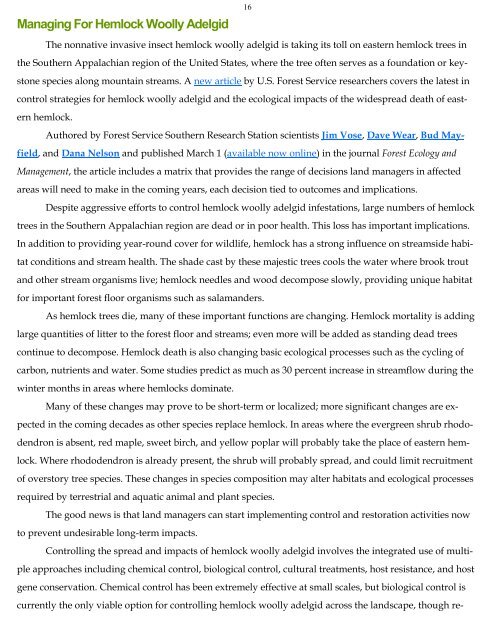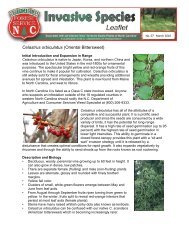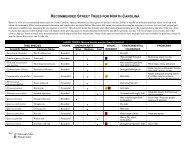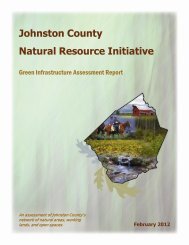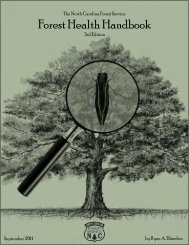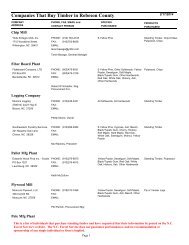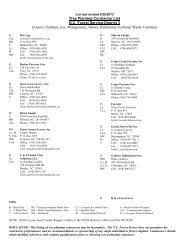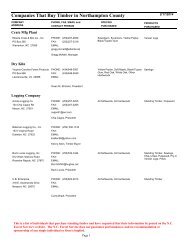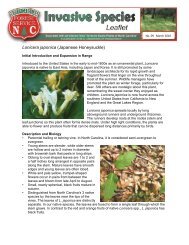Northampton County Honors the Morey's - NC Forest Service
Northampton County Honors the Morey's - NC Forest Service
Northampton County Honors the Morey's - NC Forest Service
- No tags were found...
You also want an ePaper? Increase the reach of your titles
YUMPU automatically turns print PDFs into web optimized ePapers that Google loves.
Managing For Hemlock Woolly Adelgid16The nonnative invasive insect hemlock woolly adelgid is taking its toll on eastern hemlock trees in<strong>the</strong> Sou<strong>the</strong>rn Appalachian region of <strong>the</strong> United States, where <strong>the</strong> tree often serves as a foundation or keystonespecies along mountain streams. A new article by U.S. <strong>Forest</strong> <strong>Service</strong> researchers covers <strong>the</strong> latest incontrol strategies for hemlock woolly adelgid and <strong>the</strong> ecological impacts of <strong>the</strong> widespread death of easternhemlock.Authored by <strong>Forest</strong> <strong>Service</strong> Sou<strong>the</strong>rn Research Station scientists Jim Vose, Dave Wear, Bud Mayfield,and Dana Nelson and published March 1 (available now online) in <strong>the</strong> journal <strong>Forest</strong> Ecology andManagement, <strong>the</strong> article includes a matrix that provides <strong>the</strong> range of decisions land managers in affectedareas will need to make in <strong>the</strong> coming years, each decision tied to outcomes and implications.Despite aggressive efforts to control hemlock woolly adelgid infestations, large numbers of hemlocktrees in <strong>the</strong> Sou<strong>the</strong>rn Appalachian region are dead or in poor health. This loss has important implications.In addition to providing year-round cover for wildlife, hemlock has a strong influence on streamside habitatconditions and stream health. The shade cast by <strong>the</strong>se majestic trees cools <strong>the</strong> water where brook troutand o<strong>the</strong>r stream organisms live; hemlock needles and wood decompose slowly, providing unique habitatfor important forest floor organisms such as salamanders.As hemlock trees die, many of <strong>the</strong>se important functions are changing. Hemlock mortality is addinglarge quantities of litter to <strong>the</strong> forest floor and streams; even more will be added as standing dead treescontinue to decompose. Hemlock death is also changing basic ecological processes such as <strong>the</strong> cycling ofcarbon, nutrients and water. Some studies predict as much as 30 percent increase in streamflow during <strong>the</strong>winter months in areas where hemlocks dominate.Many of <strong>the</strong>se changes may prove to be short-term or localized; more significant changes are expectedin <strong>the</strong> coming decades as o<strong>the</strong>r species replace hemlock. In areas where <strong>the</strong> evergreen shrub rhododendronis absent, red maple, sweet birch, and yellow poplar will probably take <strong>the</strong> place of eastern hemlock.Where rhododendron is already present, <strong>the</strong> shrub will probably spread, and could limit recruitmentof overstory tree species. These changes in species composition may alter habitats and ecological processesrequired by terrestrial and aquatic animal and plant species.The good news is that land managers can start implementing control and restoration activities nowto prevent undesirable long-term impacts.Controlling <strong>the</strong> spread and impacts of hemlock woolly adelgid involves <strong>the</strong> integrated use of multipleapproaches including chemical control, biological control, cultural treatments, host resistance, and hostgene conservation. Chemical control has been extremely effective at small scales, but biological control iscurrently <strong>the</strong> only viable option for controlling hemlock woolly adelgid across <strong>the</strong> landscape, though re-


